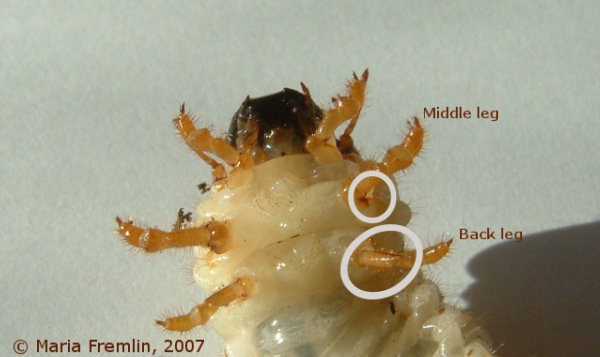Third instar stag beetle Lucanus cervus larva on millimetric paper.
Remarkably, stag beetle larvae have scrapers in their legs with which they 'play' to communicate with their mates. In other words they stridulate by scraping the back leg against a 'comb' in the middle leg. See below the dark areas inside the circles; the 'comb' on the middle leg is only partially visible though.

Video of a stridulating larva. Maria Fremlin, 26 March 2012.
For more go to Stridulation in stag beetle larvae.
So if you ever come across one in your garden, look at the way they move their legs, as they might be warning their mates. If you handle it, the skin feels nice and dry. However as they strongly dislike being handled they have a disconcerting tendency to defecate, no problem, it is a common defensive reaction. Then put it back where you found it, please, as they develop very, very slowly, indeed your larva might be quite old; also they don't relocate well.
The lesser stag beetle Dorcus parallelipipedus larvae are almost identical, though they do not reach the same size, and sometimes they can be found feeding together in log piles, etc. However in natural situations the stag beetles much prefer to feed underground, and the lesser stag beetles above the ground. Sometimes the latter can even be found feeding quite high up dead trees; therefore their gut contents look a lot paler that the stag beetles. Please have a good look at the Gardener's larva guide.
For another Lucanidae larva, the one of Lucanus capreolus, click here.
For pictures of another defecating larva click here, different family though. Note that its spiracles aren't C shaped like the ones in the Lucanidae larvae.
| Main | Stag beetles' life cycle | Stag beetle larvae | HELPLINE |